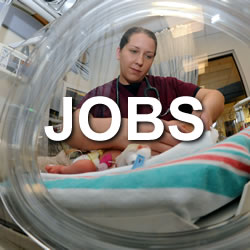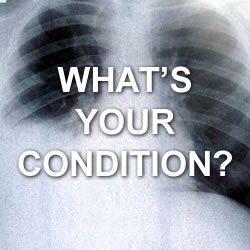Time for Mammograms to Be a Thing of the Past?
Greggory Moore | Moore Lowdown

image by: Cancer Research UK
A new study is merely the latest suggesting that mammograms may net more harm than good. With a new "breast-friendly" procedure in the works, perhaps now is the time to put the mammogram out to pasture.
In 1895, Wilhelm Röntgen discovered a high-frequency portion of the electromagnetic spectrum, which he named "X-radiation." The usefulness and success of the technology based on Röntgen's discovery is such that for generations every schoolchild has not only known the term X rays but can give you a basic idea of their most common application: to "see" into and through solid objects. Diagnosing cavities and broken bones are merely the most common of X rays' many medical applications.
In the early 1960s, detecting breast cancer was added to the list when Robert Egan developed the technique that would shortly be dubbed mammography. It wasn't the first time X rays had been applied to breast tissue—that was way back in 1913—but it was only in the late 1950s that Egan's tireless experimentation yielded a procedure that consistently pinpointed breast cancers that were so undeveloped they otherwise undetectable. It was a tremendous step forward for both medicine and for women in general, coming at a time when, as University of Colorado Department of Radiology Chair Gerald Dodd III says, "You didn’t talk about breasts, and women weren’t comfortable bringing problems to their doctor’s attention because they were afraid it would lead to an examination, which most didn’t want."
Largely thanks to mammography, our world does not resemble the one into which Egan's technology came of age. Since 1976 mammograms have been recommended a screening tool by the American Cancer Society, and today roughly two-thirds of all American women over 40 have had a mammogram within the last two years.
But in recent years mounting evidence has suggested that women have had too much of what was historically a good thing—and that perhaps mammograms have not been as good as they've been cracked up to be. For example, a 2011 BMJ study (following up on others like it) asserted that yearly mammograms may cause more harm than good, and a 2015 study published in JAMA Internal Medicine found that, while mammograms led to 16% more cancer diagnoses than would have resulted otherwise but no corresponding decrease in the mortality rate. " The cumulative case against the status quo was strong enough that in 2015 the American Cancer Society altered its position, shifting from recommending yearly mammograms for all women over 40 to annual mammograms for women aged 45–54, then adopting a biennial schedule.
Now comes what may be the most damning data batch yet. According to a team of Danish researchers who between 1980 and 2010 conducted the broadest study of mammography screening to date, mammography is not associated with a reduction in the incidence of advanced cancer, and as many as one-third of all cancer diagnoses resulting from mammograms may be an "overdiagnosis," meaning that the cancer detected by mammography would never have caused any sort of health problem for the woman during her lifetime.
The results of the study are so compelling that Dr. Otis Brawley, the American Cancer Society's chief medical officer, addressed the findings in an accompanying editorial, even though he himself was not involved with the study. “By treating all the cancers that we see, we are clearly saving some lives, but we’re also ‘curing’ some women who don’t need to be cured," he said in a follow-up interview with the PBS NewsHour, referring to the unnecessary by radiation treatment, chemotherapy, and even surgery that an overdiagnosed women may undergo.
Just as the late 1950s saw the beginnings of a paradigm shift toward mammography in the search for a more effective means to achieve an early breast cancer diagnosis, the current decade may play host to a changing of the guard. One promising candidate is digital breast tomosynthesis (DBT). Approved for use by the Food & Drug Administration in 2011, DBT provides a three-dimensional image of the breast—superior to a mammogram's two-dimensional image—while subjecting the patient to a lower, safer dose of X rays. Not to mention that the procedure does not require the uncomfortable flattening of the breast that all women who have endured mammograms know all too well.
The American College of Radiology (ACR) believes DBT is ready to deliver on the promise of a better day in breast-cancer screening. "The ACR position on DBT is that it is no longer investigational," ACR says in its policy statement on the subject. "[…] Digital breast tomosynthesis (DBT) has shown to be an advance over digital mammography, with higher cancer detection rates and fewer patient recalls for additional testing. This is extremely important. The medical community has long sought ways to improve breast cancer screening accuracy. Better sensitivity will likely translate into more lives saved. Lower recall rates result in fewer patients who may experience short-term anxiety awaiting test results. This is important evidence that tomosynthesis will have a positive impact on patient care."
Mammography will always hold a rightful place in the pantheon of medical developments, contributing to improvements in not only women's healthcare but in society's willingness to attend to women's need. But as happens with scientific progress, useful tools of one era are traded for ones better able to do the same jobs.
About the Author:
Except for a four-month sojourn in Comoros (a small island nation near the northwest of Madagascar), Greggory Moore has lived his entire life in Southern California. Currently he resides in Long Beach, CA, where he engages in a variety of activities, including playing in the band MOVE, performing as a member of RIOTstage, and, of course, writing.
His work has appeared in the Los Angeles Times, OC Weekly, Daily Kos, the Long Beach Post, Random Lengths News, The District Weekly, GreaterLongBeach.com, and a variety of academic and literary journals. HIs first novel, The Use of Regret, was published in 2011, and he is currently at work on his follow-up. For more information: greggorymoore.com

Introducing Stitches!
Your Path to Meaningful Connections in the World of Health and Medicine
Connect, Collaborate, and Engage!
Coming Soon - Stitches, the innovative chat app from the creators of HWN. Join meaningful conversations on health and medical topics. Share text, images, and videos seamlessly. Connect directly within HWN's topic pages and articles.
















